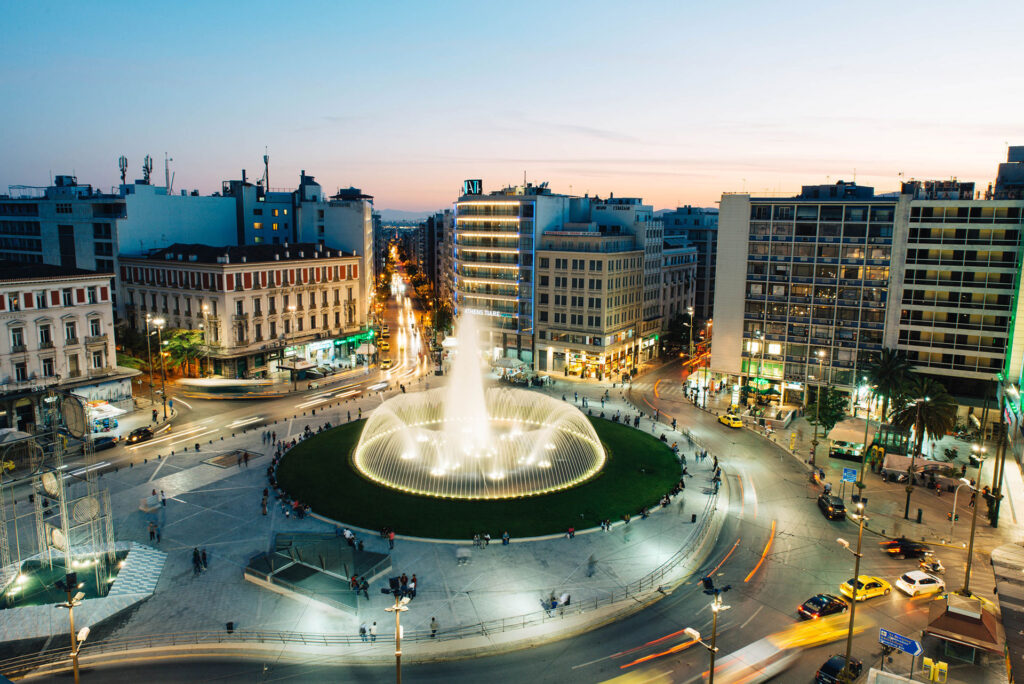The City of Athens
A bustling and cosmopolitan metropolis, Athens is central to the economic, financial, industrial, political and cultural life in Greece. Located at the crossroads of three continents, the capital of Greece, with an overall population of close to 5 million people, has often been the melting pot of many cultures. Europe’s oldest capital city, is the birthplace of democracy, arts, science and philosophy of western civilization.
Athens is an ideal congress destination, combining state-of-the-art infrastructure, excellent congress facilities and easy access from all over the world with world-class cultural attractions, modern amenities and diverse entertainment.

Past and Present
Boasting a history of 2,500 years with monuments incorporated into the modern city, coupled with world class museums and a vibrant contemporary cultural life, Athens is a very attractive destination. The establishment of Athens as a city date back to mythological times. Despite the length of the city’s history, it is still evident throughout Athens in the form of many ancient, Roman, Byzantine and Modern monuments.
A center for the arts, learning and philosophy, home of Plato’s Academy and Aristotle’s Lyceum, Athens was also the birthplace of Socrates, Pericles, Sophocles and its many other prominent philosophers, writers and politicians of the ancient world. It is widely referred to as the cradle of Western civilization and the birthplace of democracy, largely due to the impact of its cultural and political achievements during the 5th and 4th centuries B.C. on the rest of the, then known, European continent.
The heritage of the classical era is still evident in the city, represented by a number of ancient monuments and works of art, the most famous of all being the Parthenon on the Acropolis, widely considered a key landmark of early Western civilization. The city also retains a vast variety of Roman and Byzantine monuments, as well as a smaller number of remaining Ottoman monuments projecting the city’s long history across the centuries.
Landmarks of the modern era are also present, dating back to 1830 (the establishment of the independent Greek state), and taking in the Greek Parliament (19th century) and the Athens Trilogy (Library, University, and Academy).
Athens was the host city of the first modern-day Olympic Games in 1896. Having hosted the 2004 Olympic Games, Athens can evidently meet the requirements of the most demanding of events, always delivering an impeccable result.
Today’s capital is a result of integration of ancient and medieval history into the contemporary era.
Landmarks of Athens
Being one of the most historically significant cities is Europe Athens has much to offer to those who are interested in exploring some of the routes of our world’s civilization. Over the years, a multitude of conquerors occupied Athens, and erected unique and truly splendid monuments. Today’s capital integrates the ancient and medieval history into the contemporary era. Monuments can be found all around the city center, side by side with contemporary constructions such as buildings, roads and train stations.
Acropolis
The greatest and finest sanctuary of ancient Athens dominates the centre of the modern city. Main building, Parthenon was dedicated to Athena Parthenos, the patron Goddess of the city and was completed in 432 B.C.
The monuments of Acropolis, unique masterpieces of ancient architecture, combine different orders and styles of Classical art in a most innovative manner and have influenced art and culture for many centuries. Acropolis itself is the most accurate reflection of the splendour, power and wealth of Athens at its greatest peak, the golden age of Pericles.
Like all ancient monuments, they have suffered destruction and theft. But thankfully, just a stone’s throw away from the Hill and the Parthenon, the Acropolis Museum provides all the missing pieces of information needed for someone to understand its significance and all the stories it has played a role throughout the years.
Hadrian’s Arch and the Temple of Olympian Zeus
Before starting the climb to reach the Parthenon, it is impossible to miss a monument as impressive as Hadrian’s Arch. Located in the city center of Athens, just away from the Acropolis and Syntagma square, has been a distinctive Athenian landmark since time immemorial. Refers to the remnants of an ancient colossal temple that was dedicated to Zeus, the patriarch figure of all Olympian Gods and the ruler of Mount Olympus.
Constructed in 131 A.D. by the Roman Emperor, it was created to form an entrance for the new city and separate it from the old one. On the side of the monument facing the Acropolis one can see the inscription “This is Athens, the former city of Theseus” while on the other side the inscription “This is the city of Hadrian and not of Theseus.
Behind Hadrian’s Arch, stands the captivating temple of Olympian Zeus. Τhe construction of the building began in the 6th century by Peisistratus to finally be completed 100 years later, in 131 BC., by the emperor Hadrian.
Originally it consisted of 104 Corinthian columns of which only 15 remain standing today. Inside the temple, Hadrian built an enormous gold and ivory statue of Zeus and an equal one of himself. To this day we do not know when the temple was destroyed but like many other large buildings in Greece, it is possible that it was brought down by an earthquake during the mediaeval period and the ruins sold for other building materials.
Ancient Agora
The Ancient Agora, which means “market” in modern Greek, is situated at the footsteps of the Acropolis and in ancient times it served as the commercial center of the city but also as a political, cultural and religious center. Today it resembles a park and is a peaceful area that can be explored either on foot or by bicycle giving people a vivid visual of the everyday life of an ancient Athenian.
Panathenaic Stadium
Originally built in the 4th century B.C. for the athletic competitions of the Great Panathinaia (ancient Greek festivities), the “Kallimarmaron” Stadium was the venue of the first modern Olympic Games, in 1896.
A creation of the Athenians, as its name proudly proclaims, the Panathenaic Stadium has been the venue for noble competition and fair play, of mind and of body, since Antiquity.
Herodes Atticus Theater
One of the legendary sites seated beneath the slopes of the Acropolis, on the southwest side. A stunning open-air theatre be described as “the finest building of its type”.
The ancient amphitheater of Herodeion, also known as the Odeon of Herodes Atticus, is one of the best places to experience a live classical theater performance. This ancient theater was built in the Roman times, in about 161 A.D. by the Roman philosopher, teacher and politician Herodes Atticus. It was built in the memory of his wife Aspasia Regilla who died in 160 A.D.
In 1950’s the city decided to fully reconstruct the venue before its grand opening in 1955 as the prime location for the Athens and Epidaurus Festival. Today remains one of the festival’s main venues. From the majestic ballets and arias, to ancient Greek tragedies, witnessing a performance here is one you’re unlikely to forget.
Museums of Athens
National Archaeological Museum of Athens
The National Archaeological Museum of Athens is the largest in Greece and one of the most important museums in the world devoted to ancient Greek art. It was founded at the end of the 19th century to house and protect antiquities from all over Greece, thus displaying their historical, cultural and artistic value.
Click here for the National Archaeological Museum website.
Byzantine and Christian Museum
The Byzantine and Christian Museum, which is located in Athens, is one of Greece’s national museums. Its areas of competency are centered on – but not limited to – religious artifacts of the Early Christian, Byzantine, Medieval, post-Byzantine and later periods. The Museum has over 25.000 artifacts in its possession, which date from between the 3rd and 20th Century A.D.
Click here for the Byzantine and Christian Museum website.
Museum of Cycladic Art
The Museum of Cycladic Art is dedicated to the study and promotion of ancient cultures of the Aegean and Cyprus, with special emphasis on Cycladic Art of the 3rd millennium B.C. It was founded in 1986, to house the collection of Nicholas and Dolly Goulandris, an extensive and unique private collection of prehistoric art from the Cycladic islands as well as ancient Greece.
Click here for the Museum of Cycladic Art website.
The Acropolis Museum
The Acropolis Museum was founded in 2003 and completed in 2007 after decades of being born as an idea, as a place that would accommodate the missing Parthenon sculptures. Today it is focused on the findings of the archaeological site of the Acropolis of Athens. The museum was built to host every artifact found on the rock and on the surrounding slopes, from the Greek Bronze Age to Roman and Byzantine Greece. It also lies over the ruins of a part of Roman and early Byzantine Athens.
Click here for the Acropolis Museum website.
Benaki Museum
The Benaki Museum is counted among the major institutions that have enriched the material assets of the Greek state. It hosts 30.000 items illustrating the character of the Greek world through a spectacular historical panorama covering several periods ranging from the Prehistoric, Ancient and Roman periods to the Byzantine and the contemporary Hellenic period.
Click here for the Benaki Museum website.
Hellenic Cosmos Cultural Center
A living museum, an ultramodern cultural center, where visitors can learn about history, culture and sciences through interactive exhibitions, educational programs, virtual reality shows and documentaries.
Click here for the Hellenic Cosmos Cultural Center website.
The National Gallery
After going through an extensive renovation process, The National Gallery reopened to the public in 2021. Officially established in 1900, it has the world’s largest collection of Modern Greek works of art. It focuses primarily on paintings and sculptures. It also encompasses works from numerous European artists, dating all the way back to the Renaissance.
Click here for the National Gallery website.
Basil & Elise Goulandris Foundation
This is the second museum in Athens linked to the Goulandris name. Opening its doors in 2019, the Basil & Elise Goulandris Foundation is one of the newest additions to the list of cultural institutions in the Greek capital. Its permanent collection includes the works of art bought by Basil and Elise Goulandris through many years. This collection focuses primarily on 19th and 20th centuries European paintings, represented by works of Van Gogh, Picasso and Monet, among others. Greek painters, like Engonopoulos and Fassianos, are also represented.
Click here for the Basil & Elise Goulandris Foundation website.
Shopping, Gastronomy and Nightlife
Shopping
The best place for high end shopping in the city with all the big fashion names is Kolonaki. However, the most well-known shopping street in Athens is Ermou Street. It is a pedestrian road full of famous brands and shops leading to the ultimate street shopping place of Monastiraki. It is situated around the Acropolis and offers a unique environment, where you may walk on the old cobblestone roads and visit the traditional flea market and bazaar. One can find all kinds of products there from clothes, shoes, cosmetics, jewelry, and bags to even decorating items. There are multiple coffee shops around the area offering a full evening experience.
Greek Gastronomy
Greek gastronomy has recorded a history of around 4,000 years, with especial characteristics based on pure and unique quality goods produced on Greek soil. In fact, it was Archestratos who wrote the first cookbook in history (330 B.C.). In truth Greek cuisine has four secrets: good quality fresh ingredients, correct use of flavorings (herbs) and spices, the famous Greek olive oil and simplicity. Olive oil, honey, salt and cheese may be the signature tastes one remembers after having a meal here but there are many more ways to impress your palette and satisfy your cravings. Due to the ever-generous Mediterranean Sea, a Greek table is almost never complete without various delicious fresh fish.
Finally, when it comes to drinking, wine has been imbedded in the Greek culture since the ancient times and is still taken and drunk very seriously by Greeks today as there are hundreds of wineries around the country and countless wine bars in all cities and islands. Other famous Greek drinks include Ouzo, Raki and the mysterious Mastic that can only be produced in one island in Greece as the plants of its origin are unable to grow successfully anywhere else in the entire world for reasons still unknown to this day.
Nightlife and Entertainment
One of the main characteristics of Greek Culture tourists notice is the vibrant lifestyle and unique hospitality of Athenians.
From jazz bars to pubs and the clubs to the traditional Greek Bouzoukia, Athens is a vibrant city offering a wide range of options that appeal to all sorts of lifestyles and tastes.
Dinner in Greece is served relatively late compared to other countries, reservations are rarely booked before 9 pm and bars never close before 2 am. Clubs in Athens can stay open until the morning hours making every night into a special occasion where one can meet new people, as Greeks have a tendency to meet, greet and include people when they are having fun.
As a night starter, Greece is one of the few countries in Europe where all cinemas play films in their original language with complimentary subtitles, therefore allowing our visitors to enjoy the pleasure of a movie the same way they would at home country.





